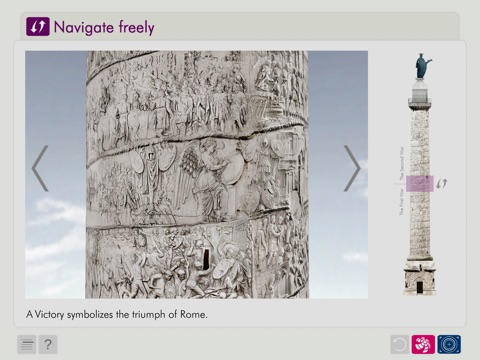
Trajan's Column app for iPhone and iPad
Developer: Mondadori Electa S.p.A.
First release : 05 Jan 2014
App size: 648.4 Mb
Trajans Column (inaugurated in AD 113) is one of the few monuments of ancient Rome that has come down to us virtually intact and, at the same time, it is the largest most important surviving ancient figurative structure.
The App, promoted by the Soprintendenza Speciale per i Beni Archaeologici di Roma and Mondadori Electa, provides a simple and immediate approach to the monument. The real time exploration using the 3D model of the column gives a completely new perspective compared to the graphic and photographic images of the reliefs published to date.
By using the App when standing at the site it is possible to examine the column by looking from the monument to the tablet and obtaining information on the scenes that are glimpsed from below (Live 3D). The immersive vision of the column, in its present context and in various historical periods, is possible, even if the user is not in the monuments immediate vicinity.
The App allows a continuous view of "The Tale" represented on the long figured frieze, with a voice over and sound effects that make it possible to fully appreciate this "marble movie" (lasting about 25 minutes).
In the "Navigate freely" section, the column can be explored in its entirety by following the spiral reliefs or moving freely with the aid of subtitles that describe the scenes.
The third section, "The Dacian wars and its players", gives access to specific information about the content of the figured frieze and the character of the protagonists (the emperor Trajan, king Decebalus, the Roman army, the Dacians).
The App also makes it possible to appreciate "The Colums through time", narrating with images and texts the events in the city around the ancient monument from antiquity to the present day. The area of the city surrounding the column is directly experienced by the user through the virtual exploration of this part of Rome in the Roman period, late medieval period, and in 1750 as if in a time machine.
The fourth section, "The Column and its Numbers", presents basic technical and architectural information about the monument.



